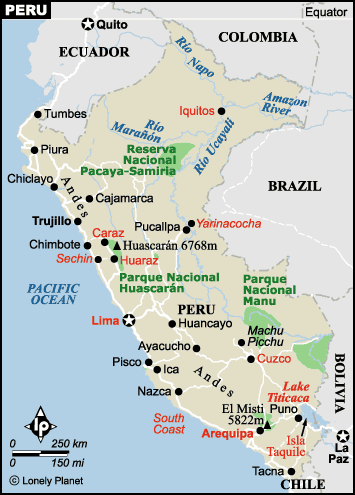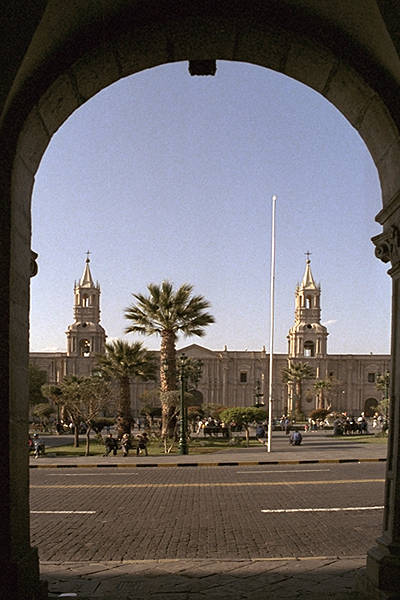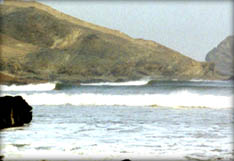|

Thanks to its strategic location, Peru is a privileged destination for tourism and one of the most attractive markets for investment. Heir to ancient cultures and a rich colonial tradition, Peru is a magical spot within a continent
which is home to more than 300 million inhabitants. The
country features possibly the richest biodiversity on Earth, and is a melting pot of different cultures who together
are forging the promise of a better future.
Path through history
Learn about the first Pan-Andean civilization, that of Chavín (1500-400 BC), which features stone temples riddled with labyrinthine galleries at altitudes over
3,100 masl. Discover the mystery of mud-brick citadels and pyramids built near the sea by the Mochica dynasty (200 BC-700
AD) and their royal tombs such as the Lord of Sipán, one of the most important archaeological discoveries of the twentieth
century.
Follow in the footsteps of the fierce Chachapoya warriors (1000-1400
AD) along 25-meter-high ramparts in the Kuélap fortress or peer into the imposing tombs of their ancestors that lie near where
the mountains plunge down into the forest. Stroll around Cuzco, the capital of the Inca empire (1300-1500 AD), the greatest
pre-Colombian civilization in South America. Cuzco and environs feature colossal constructions such as the Machu Picchu citadel,
hailed as the eighth wonder of the world.
Witness the melting pot of cultures in striking and prosperous cities
founded during the colonial era which today, with their churches, convents, monasteries and aristocratic mansions, are a showcase
of architecture and art from a bygone age (PROMPERU).
Peru: a natural paradise
Peru's
astounding variety of climates and eco-systems ranks the country amongst the world's top eight nations in terms of biodiversity,
where one can find 84 of the 104 life zones existing around the planet. The country is home to more than 400 species of mammals,
300 reptiles, 1,700 birds and more than 50,000 plants registered to date.
Nature lovers will find Peru to be a choice destination: more than 50
protected natural areas along the coastline, Andean foothills, wetlands, Amazon forest and tropical highlands, including Paracas,
Manu, Tambopata-Candamo, Pacaya-Samiria, Pampa Galeras and Huascaran. These eco-systems are unique and are a haven for dozens
of species on the verge of extinction.
Peru also features one of the world's richest fishing grounds, thanks
to its special climactic conditions and a wealth of nutrients that have give rise to a staggering number of fish species (more
than 900), mollusks, crustaceans, birds and 33 species of sea mammals (PROMPERU).
Festivals, arts and traditions
Peru will also lead visitors into a world of art and age-old wisdom,
the legacy of major pre-Hispanic civilizations such as the Quechua, Aymara and jungle peoples, whose view of the world was
based on their observation of the Heavens and Nature. Over the course of centuries, Peru incorporated the cultural contribution
of European, African and Asian migrants.
A diverse nation featuring many cultures, Peru is an endless wellspring
of creativity. In addition to its historic, archaeological and architectural legacies, folk art is another of Peru's tourist
attractions. Its rich folklore is evident in more than 1,500 musical genres, combining instruments from the outside world
with native Andean equivalents, such as the quena and zampoña flutes, which provide the accompanying music for more than 3,000
festivals such as the Candelaria, Inti Raymi, Carnivals, Corpus Christi and Easter Week.
At the same time, Peru boasts one of the most exquisite and varied cuisines
on Earth, as local chefs have succeeded in adapting a diverse variety of native ingredients while remaining open to outside
influences. Peru's cooking is an invitation to taste discover flavors and fragrant smells which are as authentic as they are
ancient (PROMPERU).

NAZCA LINES
Maximum cultural expression of the Nazca civilization. Declared "Cultural Patrimony of Humanity" by UNESCO
Unique place in the world, full with mystery and mysticism, wonderful traces
of immense figures and lines of spectacular perfection. Diverse scientific theories have been placed on these lines. Some
theories only explain its possible construction associated to extraterrestrial beings.
The great constructions of observatories of astronomical cycles, well-known
as the Nazca Lines, were used by the farmers to know and control the meteorological agrarian cycles, aside
from their possible religious significance (María Reiches theory). These lines
are traced on San José and Socos desert plains, between the 419 and 465 kms. of the South Pan-American Highway, with an extension
of 350 square km., near the Nazca city.
These lines form drawings of several kilometers in length and aproximately
0.4 and 1.1 km in width, with animal, geometric and trapezoidal forms; some of which can only be seen in all their magnitude
from an airplane. The figures of the spider, the monkey, the dog, the small lizard, the hummingbird, the condor, and the astronaut,
among others, stand out.
These lines were investigated scientifically for the first time by the Prof.
German Paul Kosok, along with the Peruvian archeologists Julio C. Tello and T. Mejía Xesspe,
denominated these lines as 'the biggest astronomy book of the world '. María Scholten carried out investigations to determine
the mathematical unit of measure that was used in the construction. Their main investigator was Dr. María Reiche.
The Nazca Lines were discovered accidentally from an airplane in flight in
1927. By the end of the 1980's new lines were discovered.
On the Pan-American Highway some observation towers can be found, which allow
a limited vision of the lines. The only possible way to appreciate them in all their magnitude, given their gigantic size,
is flying over the area on a light plane.




|
 |
|
|
 |
|
 |
 |
 |
 |
 |
 |
|
Historical Archaeological
Peru is one of the countries that has a rich millennial tradition that begins with distant historical trace of
nomads, hunters and collectors, the big pre-Inca civilizations appear, from the Chavin to the Chimú cultures, opening the
way to the great Inca Culture. Through the vast territory of the coast and mountain, we can find big and wonderful archaeological
centers, in those that you can magnify the art and development of each one of these big towns, and to come closer to them,
knowing their works, many of them harbored in museums. It will be easy to find the beauty and greatness of these archaeological
locations next to beautiful landscapes, among snowy mountains of the Mountain Range of the Andes
Machu Picchu - Cusco
Valle Sagrado de los Incas - Cusco
Nazca Lines - Nazca
Señor de Sipán, Señor de Sicán and Túcume - Chiclayo
Chan Chan - Trujillo
Chavín of Huántar - Huaraz
Cumbemayo and Otuzco - Cajamarca
Colca Valley - Arequipa
MACHU PICCHU ("THE HOLY CITY OF THE INCAS" "THE LOST CITY" )
Patrimony of the Humanity. It is a mystical place, a monument to divinity, where people can feel that they are a creation
of God. The high sense of spirituality that inhabits this place seems to transport its visitors to a place where everything
"in an unimaginable way" is possible.
It is a place where strange forces of nature allow the individuals to reach an incomparable cosmic state, a state that
can only be experimented in Machu Picchu. It is one of the most popular archeological sites of the world, and therefore, the
most visited attraction in Peru.
The Citadel of Machu Picchu (in Quechua [an Andean language] = Old Mountain) is known throughout the world for its amazing
ruins and its unusual location on a high mountain overlooking the mighty currents of the Urubamba river.
Even today nobody has been able to solve the mystery how the builders and designers managed to transport the huge blocks
of limestone to the top of the mountain required for the construction of the city. Probably built during the 15th century
in a very difficult location, it is the greatest achievement of the Incas architects due to the intelligence and dare demonstrated
by their design. It has an extent of 13 sq/km and its main functions were military and religious. It used to be surrounded
by an outer wall with a height of 6.00 m. and a width of 1.80 m. and it is estimated that it was inhabited by 10000 people.
Built of limestone (the outer and inner walls), wood (doors and frames), and ceilings made of straw.
Machu Picchu is located 2300 meters above sea level (7546 ft.), at 112 km. (70 miles) from Cusco, in the valley of Urubamba
in the lowest part of the Sacred Valley of the Incas in a area of direct access to the upper jungle. Without doubt, Machu
Picchu was part of a very big complex of fortresses which defended the Andean lands in Sacred valley of any assault from indian
people out of the Jungle. Having Huayna Picchu as a background they divided Machu Picchu in four sectors. Northwest is located
the area that was probably used for the main religious purposes, that includes a Plaza named by Hiram Bingham as "Sacred Plaza",
also the temple of the "Three Windows", "The Sacred Temple", the "Priests Mansion", and the "Intihuatana" that is a large
block of limestone used during Inca ceremonies.
The "Intihuatana" (in Quechua = place where the sun is bonded) is a solar observatory that allowed the Incas to keep
track of the seasons of the year and the flow of time based on the shadows caused by the sun over the stone.
The largest residences are located on the northeast of the complex. The most luxurious residences and also a watch tower
are located on the southwest of the complex and therefore it is assumed that this part of the Citadel was probably the heart
of all the urban activities.
To the southeast of the complex are located the smallest and most humble of the buildings built around very narrow streets,
close to numerous terraces constructed for agricultural purposes as denoted by the existence of a very complex aqueduct system
in this area. In the lowest part of the terraces is a cementery, where during a search were discovered 135 skeletons and 109
of them were identified as females. This fact has allowed historians and archeologists to believe that Machu Picchu's inhabitants
were mostly females that could have been the chosen ones of the Inca, fleeing from Cusco when it was overrun by the Conquerors
of Spain and seeking refuge in Machu Picchu that, by the way, was never discovered by the Spaniards.
The minimum recommended time to visit Machu Picchu is one day.

VALLE
SAGRADO DE LOS INCAS (SACRED VALLEY OF THE INCAS)
Called this way to the end of the extensive valley of Urubamba,
near Cusco where the agricultural cattlemen and beautiful towns were concentrated since Inca times.
The valley is characterized to have very special conditions, as an excellent
climate, very fertile lands and the waters of the sacred river of the Inca, the Vilcanota (in Quechua language:
sacred or wonderful thing) that, in the town of Urubamba, changes name to Urubamba River. "Valle Sagrado" is embraced between
the towns of Písac and Ollantaytambo, it has wonderful landscapes where its inhabitants, native of the Quechua ethnic, conserve
many customs and ancestral rites.
It is the area where you can appreciate and magnify the high technological
development that the Inca reached in the agriculture through "andenería" systems (platform systems that are a group of earth
patches arranged in steps on the hills to be used in the sow). These systems are still today in full production, with sophisticated
designs and hydraulic engineering works that they used for watering. Also outstanding adoration centers to the Pachamama (mother
earth).
Each town in the "Valle Sagrado de los Incas", today has the coalition of the
Inca and Spanish architectural style. The people's wealth in folklore and crafts, their way of life, their clothing, transform
it into a place that will leave in you unforgettable memories.
Písac
Picturesque
town located in the skirts of Intihuatana hill (place where the sun is tied). It has the best "andenería" system (platform
system) achieved by the Inca in all the Andes. Near the town is located the "Parque
Arqueológico de Pisac" (Archaeological Park of Písac), Inca archaeological locations, constructions in finely assembled
refined stone, citadel, turrets, military fortresses, astronomical observatories, etc. Outstands the Inca cemetery, the biggest
of America.
Every Sunday is celebrated the Sunday feast, headed by the caciques or bosses
of Ayllus carrying their "varáyoc" and typical suits, folkloric dance and mass in Quechua. Every Sunday is also carried out
the "catu" that is the indigenous fair of exchange of agricultural products in which the exchange, alive custom of Inca character
prevails.
Every Thursday and Sunday is carried out in the Main Square a crafts fair,
outstanding beautiful textile crafts, sweaters, ponchos, bags, etc. and the crafts made out of ceramic with reproductions
of Inca archaeological pieces, the queros (ceremonial glasses), necklaces, etc. To this fair artisans and indigenous merchants
of many towns go to be supplied and to trade their products.
Písac is located at 32 kms. (20 miles) from Cusco, 2,972 meters above sea level
(9,751 feet).
Calca
Town located between beautiful landscapes, in an atmosphere of peace and tranquility
that has as a beautiful background, the snowy mountains of Pitusira and Sahuasiray. Near the town are the medicinal spas of
Machacancha (thermal sulfurous springs) and Minasmoqo (cold gassy springs). Near Calca is located the archaeological Inca
complex Huchuy Cusco.
Calca is located at 50 kms. (31 miles) from Cusco, 2,928 meters above sea level
(9,606 feet).
Yúcay
The beauty of its landscape, and the benign of the weather made of Yúcay the
elected place for the Inca royalty resort, which is also attributed to be a place with mythological character and powers on
the human spirit.
The fertility of its lands transformed it into one of the main centers of agricultural
production during the Inca time, big "andenerías" (platforms). Numerous Inca constructions exist, outstanding among those
the Palace of the Inca Sayri Túpac, stone and adobe construction with decorations in its walls on high and
low embossment.
In the town a small place museum exists; comfortable and good hotels exist
in the area. It is located at 68 kms. (42 miles) from Cusco, and 2,857 meters above sea level (9,373 feet).
Urubamba
Other old Inca town, located in fertile valley, formerly great agricultural
producer center of the Inca, and today a beautiful countryside, with great production of fruit bearing.
Urubamba is in the skirts of the majestic snowy mountain Chicón, to which you
can arrive easily and achieve its ascent. Urubamba is also called the "Capital
Arqueológica del Perú" (Archaeological Capital of Peru), for the rich Inca archaeological locations that exist in
the area; also called "La Perla del Vilcanota", for the incomparable landscapes that surround it, natural
scenarios of an indescribable beauty. Indigenous communities of marked ancestral customs exist.
Urubamba is also ideal scenery for the practice of numerous adventures sports,
as canoeing, hiking, mountain biking and horse rides. From Urubamba, good penetration routes exist to undertake adventures
in the forest of Cusco.
In the town and periphery exist comfortable and good hotels. It is located
at 72 kms. (45 miles) from Cusco, via Písac, and at 58 kms. (36 miles) by Chinchero; 2,871 meters above sea level (9,419 feet)
Ollantaytambo
The legend counts that Ollántay (the titan of the Andes) of
plebeian origin, loved the princess Cusi Coyllor (cheerful star) the Inca king's daughter Pachacútec, who was in disagreement
with this love. Pachacútec sent the princess to a house of Virgins; Ollántay tried to abduct her, without getting her, being
able to escape. From the fortress that Ollántay controlled he rebelled against Pachacútec, and after bloody battles was defeated,
but the generosity of Pachacútec forgave the life of Ollántay.
The foundation of Ollantaytambo is attributed to Ollántay, and the military
fortress that protected this area of the valley prevails strategically located between two mountains. Actually you can visit
this fortress, and also the rich Inca archaeological locations, conformed by the temple to Inti (god sun), the icamisana,
the spas of the Ñustas (princesses), the chullpas of Cachiccata, a group of terraces symmetrical and steep stairs in the slope
of a hill.
In the summit of the archaeological complex out stand six monoliths of enormous
size, assemblings with incredible precision, that have mysterious engravings of Inca iconography.
The current town of Ollantaytambo, has many houses built on the bases of the
old Inca town where natives of ingrained ancestral customs inhabit.
The complexity and beauty of the Inca constructions and the contemporary town,
the immense agricultural complex, great administrative and social center, religious and military, is considered by many scientists
and historians like one of the most important alive museums in the world.
Ollantaytambo is located at 97 kms. (60 miles) from Cusco, 2,846 meters above
sea level (9,337 feet). Train station to Machu Picchu.
The whole "Valle Sagrado de los Incas", is also a natural scenery, where besides
appreciating the archaeological wealth, is an ideal place to enjoy its rich flora and fauna, observation
of wild birds, and the practice of adventures sports
The diversity of its micro weathers allows the production of a big quantity
of variety species of height flowers that beautify its sowed fields with immense variety of potatoes, cereals, vegetables,
fruit-bearing and ornamental plants. In the area it will be common to find deers, chinchillas, vizcachas, foxes, Andean doves,
and infinity of birds and beautiful hummingbirds. In the Vilcanota River you can fish delicious salmon-like and rainbow trout,
especially among the months of April to October.
|
 |
|
|
|